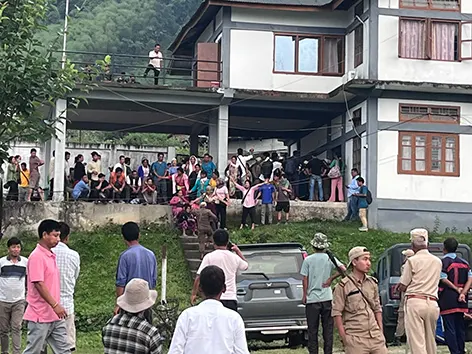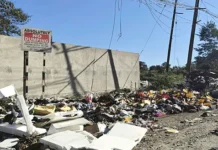[ Marina Dai ]
BOLENG, 27 May: A meeting was held at the deputy commissioner’s office in Boleng in Siang district on Tuesday to discuss the deployment of Central Armed Police Forces (CAPF) personnel for the pre-feasibility report (PFR) survey for the proposed 12,500 MW Siang Upper Multipurpose Project (SUMP). However, no conclusive decision was reached.
The Siang Indigenous Farmers’ Forum (SIFF) submitted a memorandum, demanding immediate withdrawal of CAPF personnel from Siang, Upper Siang, and East Siang districts. It also called for the removal of drilling machines from the Beging survey site and sought assurance that no further activities related to the PFR for the SUMP would proceed without free, prior, and informed consent of the local communities.
SIFF representatives stated that minister Ojing Tasing acknowledged the gravity of the matter but explained that he lacked the authority to make decisions. He proposed holding additional meetings in the future to continue the dialogue.
Many participants expressed dissatisfaction with the outcome, stating that the concerns of the villagers were not adequately addressed by either the minister or MLA Oni Panyang. Adum Tayum, president of the SIFF youth wing, remarked, “We are not satisfied with today’s meeting. Our demands were not properly discussed. The officials only spoke about reviewing the PFR, not the concerns we raised. More villagers will join the protest now. This meeting had no meaning.”
Meanwhile, the ongoing protest against the CAPF deployment at the Beging survey site continues. Locals remain resolute in their opposition, vowing to persist until the CAPF personnel are withdrawn and the survey camp is dismantled.
Tuesday’s meeting was attended by representatives of the SIFF, the Adi Students’ Union, affected members of the public, MLA Oni Panyang, minister Tasing, the deputy commissioner, the superintendent of police, the Pangin ADC, and the Boleng EAC.
Villagers in both Siang and Upper Siang districts have opposed the deployment of armed personnel in Beging for the proposed project. The forces have been deployed in Beging, Geku, Yingkiong, and Boleng, as confirmed by the IGP (law and order).
The issue of advocate Ebo Mili, legal adviser to the SIFF, who has been missing since Monday, was also raised during the meeting. A complaint had been filed against Mili on Monday by the DC, PN Thungon, accusing Mili of leading a group of 80-90 people at the Beging site, the epicentre of the protest, on 22 May. Beging is the protest site where drilling machines and other equipment have been kept by the dam proponent.
However, villagers from Beging denied these allegations, stating that Mili was present in his capacity as legal counsel to the SIFF and did not incite or lead any unlawful activity. In response to queries from this daily, the police stated that Mili is not in their custody.
Following the complaint, Mili has gone missing. He was last seen leaving Parong in Siang district at around 6:30 pm, and his current whereabouts are unknown, raising serious concerns among villagers, who are now demanding answers about his disappearance.
The villagers are protesting against the deployment of CAPF, claiming that they have been forcibly deployed in Beging, the proposed site for carrying out activities to prepare the pre-feasibility report (despite ongoing protests by the affected villagers).
The government’s initial plans for the Lower Siang HEP (2,700 MW) and the Siang Upper HEP Stage-II (3,750 MW) had already faced resistance for over two decades. Amid growing fears and opposition, the capacity was expanded to 11,000 MW without new studies, triggering a wave of protests.
Earlier, the National Institution for Transforming India (NITI) Aayog had proposed a 10,000 MW Siang project, aiming to build a single multipurpose river valley project on the Siang River, featuring a 300-metre-high dam and a power generation capacity of 10,000 MW to “moderate floods and erosion, providing relief in downstream river reaches of Arunachal and Assam.”



